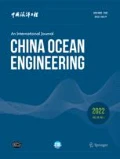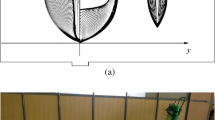Abstract
Trimaran hydrodynamics have been an important research topic in recent years. Trimarans have even been chosen for naval surface combatants. In this case, investigation of a trimaran with different outrigger positions is important and necessary for better hydrodynamic performance. This paper focuses on the numerical investigation of trimaran hydrodynamics. The trimaran model used in this study is a 1/80 scale high-speed displacement frigate-type concept developed by the Center for Innovation in Ship Design (CISD) at Naval Surface Warfare Center, Carderock Division (NSWCCD). The numerical simulations were conducted for different outrigger positions at low and moderate Froude numbers by using commercial CFD software solving URANS equations. A verification and validation study was carried out for the numerical method in one configuration and one ship velocity. The existing experimental results for the trimaran resistance in the literature were used for validation. Five different outrigger positions were analyzed and the form factor of each configuration was calculated by the Prohaska method. The total resistance was decomposed to its components using the form factor. The interference factor was calculated for each configuration in terms of total resistance, residual resistance and wave resistance. Also, wave profiles using the longitudinal wave cuts in different locations were obtained both numerically and experimentally. It was concluded that the outrigger position had different effects on the interference, total resistance and wave profile at different Froude numbers. It was also shown that the CFD results were in good agreement with the experimental data in all configurations. In conclusion, this study presents the results of interference effects for different trimaran configurations in terms of wave resistance in addition to the total resistance and residual resistance. The numerical method was validated not only with the total resistance test data but also the longitudinal wave profiles along the hull.
Similar content being viewed by others
References
Battistin, D., 2000. Analytical, numerical and experimental investigation on the wave resistance interference phenomenon of trimaran configurations, Proceedings of the NAV2000 International Conference on Ship and Shipping Research, Venice, Italy.
Celik, I.B., Ghia, U., Roache, P.J., Freitas, C.J., Coleman, H. and Raad, P.E., 2008. Procedure for estimation and reporting of uncertainty due to discretization in CFD applications, Journal of Fluids Engineering, 130(7), 078001.
Dogrul, A., Song, S. and Demirel, Y.K., 2020. Scale effect on ship resistance components and form factor, Ocean Engineering, 209, 107428.
Du, L., Hefazi, H. and Sahoo, P., 2019. Rapid resistance estimation method of non-Wigley trimarans, Ships and Offshore Structures, 14(8), 910–920.
Elcin, Z., 2003. Wave Making Resistance Characteristics of Trimaran Hulls, MSc. Thesis, Naval Postgraduate School, Monterey, California.
ITTC, 1957. Report of resistance committee, Proceedings of the 8th ITTC, Madrid.
ITTC, 2008. Testing and extrapolation methods, general guidelines for uncertainty analysis in resistance towing tank tests, Proceedings of the ITTC — Recommended Procedures and Guidelines.
ITTC, 2011. Practical guidelines for ship CFD applications, Proceedings of 26th ITTC, Hague.
ITTC, 2014a. 7.5-03-01-01 Uncertainty analysis in CFD, verification and validation methodology and procedures, Proceedings of the ITTC — Recommended Procedures and Guidelines.
ITTC, 2014b. 7.5-03-02-03 Practical guidelines for ship CFD applications, Proceedings of the ITTC — Recommended Procedures and Guidelines.
Larsson, L. and Raven, H.C., 2010. The Principles of Naval Architecture Series: Ship Resistance and Flow, The Society of Naval Architects and Marine Engineers, Jersey City, NJ.
Michell, J.H., 1898. XI. The wave-resistance of a ship, The London, Edinburgh, and Dublin Philosophical Magazine and Journal of Science, 45(272), 106–123.
Ozdemir, Y.H., Cosgun, T., Dogrul, A. and Barlas, B., 2016. A numerical application to predict the resistance and wave pattern of KRISO container ship, Brodogradnja, 67(2), 47–65.
Prohaska, C.W., 1966. A simple method for the evolution of the form factor and low speed wave resistance, Proceedings of the 11th ITTC, Tokyo, Japan, pp. 65–66.
Qi, J.J., 2008. Experimental Study for the Optimization of Side-Hull Location for Resistance of A Trimaran, Ph.D. Thesis, Stevens Institute of Technology, Hoboken, New Jersey.
Sahoo, P.K., Mynard, T., Mikkelsen, J. and McGreer, D., 2008. Numerical and experimental study of wave resistance for trimaran hull forms, Proceedings of the 6th International Conference on HighPerformance Marine Vehicles, Naples, Italy, pp. 117–132.
Sezen, S., Delen, C., Dogrul, A. and Atlar, M., 2021. An investigation of scale effects on the self-propulsion characteristics of a submarine, Applied Ocean Research, 113, 102728.
Sezen, S., Dogrul, A., Delen, C. and Bal, S., 2018. Investigation of self-propulsion of DARPA Suboff by RANS method, Ocean Engineering, 150, 258–271.
Son, C.H., 2015. CFD Investigation of Resistance of High-Speed Trimaran Hull Forms, Ph.D. Thesis, The College of Engineering at Florida Institute of Technology, Melbourne, Florida.
Song, S., Demirel, Y.K. and Atlar, M., 2019. An investigation into the effect of biofouling on the ship hydrodynamic characteristics using CFD, Ocean Engineering, 175, 122–137.
Song, S., Demirel, Y.K. and Atlar, M., 2020. Penalty of hull and propeller fouling on ship self-propulsion performance, Applied Ocean Research, 94, 102006.
Stern, F., Wilson, R.V., Coleman, H.W. and Paterson, E.G., 2001. Comprehensive approach to verification and validation of CFD simulations—part 1: Methodology and procedures, Journal of Fluids Engineering, 123(4), 793–802.
Tezdogan, T., Demirel, Y.K., Kellett, P., Khorasanchi, M., Incecik, A. and Turan, O., 2015. Full-scale unsteady RANS CFD simulations of ship behaviour and performance in head seas due to slow steaming, Ocean Engineering, 97, 186–206.
Wang, Z. and Lu, X.P., 2011. Numerical simulation of wave resistance of trimarans by nonlinear wave making theory with sinking and trim being taken into account, Journal of Hydrodynamics, 23(2), 224–233.
Wilcox, D.C., 2006. Turbulence Modeling for CFD, third ed., DCW Industries, La Cãnada, Calif.
Xu, M. and Zhang, S.L., 2011. A numerical study on side hull optimization for trimaran, Journal of Hydrodynamics, 23(2), 265–272.
Yeung, R.W., Poupard, G., Toilliez, J.O., Söding, H., Gotman, A.S. and van Hemmen, H.F., 2004. Interference-resistance prediction and its applications to optimal multi-hull configuration design, Transactions — Society of Naval Architects and Marine Engineers, 112, 142–168.
Yildiz, B., Sener, B., Duman, S. and Datla, R., 2020. A numerical and experimental study on the outrigger positioning of a trimaran hull in terms of resistance, Ocean Enineering, 198, 106938.
Acknowledgements
The authors gratefully acknowledge the support of Ms. Kelly Cooper, ONR program manager, and Dr. Colen Kennel, technical director of the Center of Innovation in Ship Design (CISD), for providing the lines drawings.
Funding
The second author was supported by the Scientific and Technological Research Council of Turkey (TUBITAK) 2219 International Postdoctoral Research Fellowship Program.
Author information
Authors and Affiliations
Corresponding author
Rights and permissions
About this article
Cite this article
Dogrul, A., Yildiz, B. Numerical Prediction of Form Factor and Wave Interference of A Trimaran for Different Outrigger Positions. China Ocean Eng 36, 279–288 (2022). https://doi.org/10.1007/s13344-022-0024-9
Received:
Revised:
Accepted:
Published:
Issue Date:
DOI: https://doi.org/10.1007/s13344-022-0024-9




